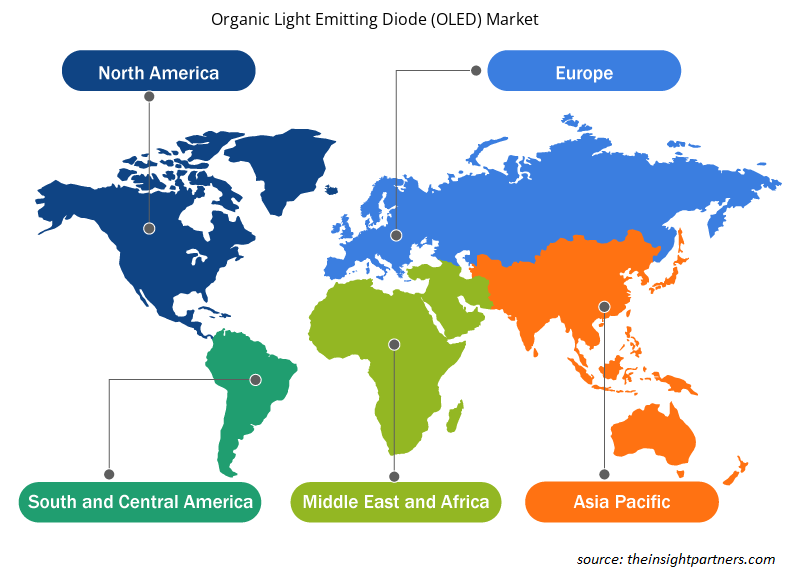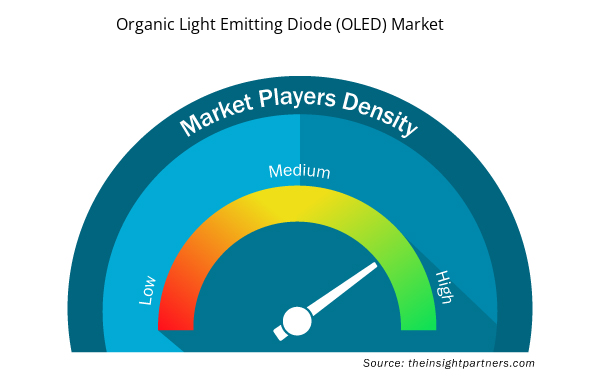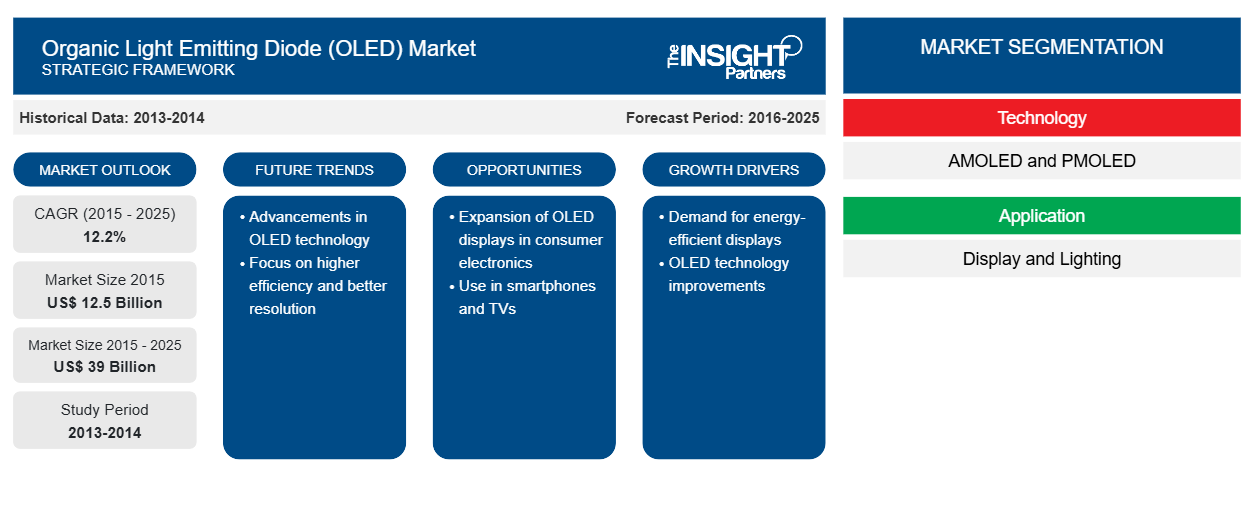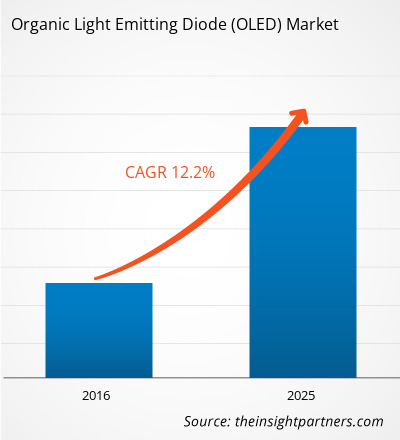2015 年有机发光二极管 (OLED) 市场价值为 125 亿美元,预计到 2025 年将达到 390 亿美元;预计 2015 年至 2025 年的复合年增长率为 12.2%。
OLED 由聚合物制成,通电后会发光。OLED 的应用领域非常广泛,例如零售、安防、汽车、建筑等。OLED 技术广泛应用于各种消费电子产品,包括手机显示屏、蓝牙耳机、汽车音响显示屏、手持游戏机、MP3 播放器、数码相机以及许多其他工业应用。OLED 的两个主要应用领域是照明和显示。目前,在柔性 OLED 方面投入大量精力的三个地区是东亚、欧洲和北美。
有机发光二极管 (OLED) 市场机会不断增长,并且正在进行大量资本投资以促进未来几年产品价格具有竞争力。目前市场上的 OLED 显示器仍然很昂贵,但随着技术的进步,价格有望下降。目前显示器性能的进步提高了产品竞争力,预计对小型显示器(尤其是智能手机)的需求将迅速增长。而对于大型显示器市场,对带有 OLED 显示器的平板电视的需求预计在不久的将来会增长。
OLED 市场按地域可分为北美、欧洲、亚太地区、南美和中东及非洲地区。包括绿色技术在内的节能显示器的生产推动着几乎每个地区的 OLED 市场增长。随着公众对环保产品的认识不断提高,索尼、苹果、飞利浦和三星等公司正在利用 OLED 提高显示效率。由于知道 LCD 屏幕和等离子屏幕消耗更多能源,生产商也在开发能耗更低、更灵活的 OLED 显示器。全球 OLED 市场的现状表明,亚太地区占据主导地位,其次是北美。两家主要的 OLED 显示器制造公司 LG Display 和三星 Display 主要集中在韩国,这两家公司都在不断专注于提高生产能力和制造大尺寸 OLED 面板。除了上述公司之外,大多数 OLED 显示器制造公司都在亚太地区,尤其是台湾和中国,并且正在大力投资 OLED 面板的研发,旨在通过降低制造过程中产生的成本来提高生产力。随着新公司投资 OLED 制造业务以及 OLED 技术发展的最新进展,预计预测期内增长将会增加。
市场洞察
微型显示器在各个垂直领域的应用日益广泛
显示技术已成为我们日常生活中无处不在的一部分。微型显示器是一种极小的显示器,对角线长度小于 25 毫米。这些显示单元具有放大显示单元使用的高分辨率和高密度屏幕。微型显示器大约在二十年前推出。微型显示器应用于工业、商业、航空航天、军事、汽车、医疗和执法及救援等各个垂直行业。微型显示器主要用于军事和航空航天的 HMD 和 HUD。Micro-OLED 是向军事和航空航天垂直行业提供基于 OLED 的微型显示器的先驱。这些显示单元提高了图像的分辨率并消耗更少的电量。
基于类型的市场洞察
有机发光二极管 (OLED) 在电流作用下会产生光。这些器件主要由聚合物和其他有机小分子组成,有望在平板显示器中实现多种应用,取代过时的阴极射线管 (CRT) 技术。全球 OLED 市场主要分为两类:无源矩阵有机发光二极管 (PMOLED) 和有源矩阵有机发光二极管 (AMOLED)。
基于应用的市场洞察
全球有机发光二极管市场根据应用细分为 OLED 显示器和 OLED 照明。OLED 用于在电视屏幕、计算机显示器和便携式设备(如手持游戏机、移动电话和 PDA)等设备中生产数字显示器。OLED 显示器能够显示深黑色级别,与 LCD 相比更轻更薄,因为它没有背光。OLED 灯由夹在两个电极之间的半导体材料组成。OLED 是绿色、蓝色和红色薄膜薄层的组合,可释放更柔和的白光。
基于最终用户的市场洞察
OLED 的灵活性使制造商能够使用卷对卷制造工艺制造 OLED,并能够生产柔性照明和显示产品。OLED 在商业上是在刚性玻璃基板上制造的。不过,最近市场上出现了诸如弯曲显示器或带有柔性 OLED 的手表等应用。要开发足够灵活和耐用的 OLED,需要进一步开发生产工艺和工具以及更好的材料。OLED 的全球市场根据最终用户垂直领域细分为零售照明、安全和标牌、汽车、消费品、建筑和其他(工业、食品、医疗等)。
定制此报告以满足您的需求
您可以免费定制任何报告,包括本报告的部分内容、国家级分析、Excel 数据包,以及为初创企业和大学提供优惠和折扣
- 获取此报告的关键市场趋势。这个免费样品将包括数据分析,从市场趋势到估计和预测。
产品开发是公司扩大产品组合的常用策略。欧司朗、OLEDWORKS、LG、Acuity Brands 等是实施扩大客户群和在全球有机发光二极管 (OLED) 市场获得显著份额的战略的主要参与者,这反过来又使他们能够保持自己的品牌名称。最近的一些关键发展包括:
- 2014 年,双叶株式会社宣布与模具和塑料成型产品的制造商和销售商三光合成株式会社进行资本和业务合作。这将有利于该公司开发新产品和新技术、增加订单和开拓市场、共享设施并分享管理和生产实践。
- 2016 年 2 月,三星宣布公司将投资约 30 亿美元用于 OLED 电视生产,开发 OLED 电视面板。
有机发光二极管 (OLED) 市场区域洞察
Insight Partners 的分析师已详尽解释了预测期内影响有机发光二极管 (OLED) 市场的区域趋势和因素。本节还讨论了北美、欧洲、亚太地区、中东和非洲以及南美和中美洲的有机发光二极管 (OLED) 市场细分和地理位置。

- 获取有机发光二极管 (OLED) 市场的区域特定数据
有机发光二极管 (OLED) 市场报告范围
| 报告属性 | 细节 |
|---|---|
| 2015年市场规模 | 125亿美元 |
| 2025 年市场规模 | 390亿美元 |
| 全球复合年增长率(2015 - 2025) | 12.2% |
| 史料 | 2013-2014 |
| 预测期 | 2016-2025 |
| 涵盖的领域 | 按技术分类
|
| 覆盖地区和国家 | 北美
|
| 市场领导者和主要公司简介 |
|
市场参与者密度:了解其对商业动态的影响
有机发光二极管 (OLED) 市场正在快速增长,这得益于终端用户需求的不断增长,而这些需求又源于消费者偏好的不断变化、技术进步以及对产品优势的认识不断提高等因素。随着需求的增加,企业正在扩大其产品范围,进行创新以满足消费者的需求,并利用新兴趋势,从而进一步推动市场增长。
市场参与者密度是指在特定市场或行业内运营的企业或公司的分布情况。它表明在给定市场空间中,相对于其规模或总市场价值,有多少竞争对手(市场参与者)存在。
有机发光二极管 (OLED) 市场的主要公司有:
- 双叶株式会社
- 三星电子有限公司
- 环球显示器公司
- 昆山维信诺显示技术有限公司
- 深圳市迪莱克显示技术有限公司
免责声明:上面列出的公司没有按照任何特定顺序排列。

- 获取有机发光二极管 (OLED) 市场顶级关键参与者概览
有机发光二极管 (OLED) 市场细分:
有机发光二极管 (OLED) 市场 - 按类型
- 无源矩阵有机发光二极管 (PMOLED)
- 有源矩阵有机发光二极管(AMOLED)。
有机发光二极管 (OLED) 市场 - 按应用
- OLED 显示屏
- OLED 照明
有机发光二极管 (OLED) 市场 - 按最终用户
- 零售照明
- 安全与标牌
- 汽车
- 消费产品
- 建筑学
- 其他的
有机发光二极管 (OLED) 市场 - 公司简介
- LG Display
- 三星显示器有限公司
- 双叶公司
- 环球显示器公司
- 铼德科技
- 欧司朗有限公司
- OLEDWorks有限责任公司
- 群创光电
- 精工爱普生株式会社
- Acuity Brands Lighting Inc.
- 荷兰皇家飞利浦公司
- 历史分析(2 年)、基准年、预测(7 年)及复合年增长率
- PEST 和 SWOT 分析
- 市场规模价值/数量 - 全球、区域、国家
- 行业和竞争格局
- Excel 数据集



Report Coverage
Revenue forecast, Company Analysis, Industry landscape, Growth factors, and Trends

Segment Covered
This text is related
to segments covered.

Regional Scope
North America, Europe, Asia Pacific, Middle East & Africa, South & Central America

Country Scope
This text is related
to country scope.
Trends and growth analysis reports related to Electronics and Semiconductor : READ MORE..
The List of Companies
- FUTABA CORPORATION
- Samsung Electronics Co., Ltd.
- Universal Display Corporation
- Kunshan Visionox Display Technology Co., Ltd
- DLC Display Co., Limited
- Pioneer Corporation
- Sony Corporation
- Koninklijke Philips N.V
- Acuity Brands Lighting Inc
- SEIKO EPSON CORPORATION
- Innolux Corporation
- OLEDWorks LLC
- LG Electronics Inc
- OSRAM GmbH
- RITEK Corporation
The Insight Partners performs research in 4 major stages: Data Collection & Secondary Research, Primary Research, Data Analysis and Data Triangulation & Final Review.
- Data Collection and Secondary Research:
As a market research and consulting firm operating from a decade, we have published and advised several client across the globe. First step for any study will start with an assessment of currently available data and insights from existing reports. Further, historical and current market information is collected from Investor Presentations, Annual Reports, SEC Filings, etc., and other information related to company’s performance and market positioning are gathered from Paid Databases (Factiva, Hoovers, and Reuters) and various other publications available in public domain.
Several associations trade associates, technical forums, institutes, societies and organization are accessed to gain technical as well as market related insights through their publications such as research papers, blogs and press releases related to the studies are referred to get cues about the market. Further, white papers, journals, magazines, and other news articles published in last 3 years are scrutinized and analyzed to understand the current market trends.
- Primary Research:
The primarily interview analysis comprise of data obtained from industry participants interview and answers to survey questions gathered by in-house primary team.
For primary research, interviews are conducted with industry experts/CEOs/Marketing Managers/VPs/Subject Matter Experts from both demand and supply side to get a 360-degree view of the market. The primary team conducts several interviews based on the complexity of the markets to understand the various market trends and dynamics which makes research more credible and precise.
A typical research interview fulfils the following functions:
- Provides first-hand information on the market size, market trends, growth trends, competitive landscape, and outlook
- Validates and strengthens in-house secondary research findings
- Develops the analysis team’s expertise and market understanding
Primary research involves email interactions and telephone interviews for each market, category, segment, and sub-segment across geographies. The participants who typically take part in such a process include, but are not limited to:
- Industry participants: VPs, business development managers, market intelligence managers and national sales managers
- Outside experts: Valuation experts, research analysts and key opinion leaders specializing in the electronics and semiconductor industry.
Below is the breakup of our primary respondents by company, designation, and region:

Once we receive the confirmation from primary research sources or primary respondents, we finalize the base year market estimation and forecast the data as per the macroeconomic and microeconomic factors assessed during data collection.
- Data Analysis:
Once data is validated through both secondary as well as primary respondents, we finalize the market estimations by hypothesis formulation and factor analysis at regional and country level.
- Macro-Economic Factor Analysis:
We analyse macroeconomic indicators such the gross domestic product (GDP), increase in the demand for goods and services across industries, technological advancement, regional economic growth, governmental policies, the influence of COVID-19, PEST analysis, and other aspects. This analysis aids in setting benchmarks for various nations/regions and approximating market splits. Additionally, the general trend of the aforementioned components aid in determining the market's development possibilities.
- Country Level Data:
Various factors that are especially aligned to the country are taken into account to determine the market size for a certain area and country, including the presence of vendors, such as headquarters and offices, the country's GDP, demand patterns, and industry growth. To comprehend the market dynamics for the nation, a number of growth variables, inhibitors, application areas, and current market trends are researched. The aforementioned elements aid in determining the country's overall market's growth potential.
- Company Profile:
The “Table of Contents” is formulated by listing and analyzing more than 25 - 30 companies operating in the market ecosystem across geographies. However, we profile only 10 companies as a standard practice in our syndicate reports. These 10 companies comprise leading, emerging, and regional players. Nonetheless, our analysis is not restricted to the 10 listed companies, we also analyze other companies present in the market to develop a holistic view and understand the prevailing trends. The “Company Profiles” section in the report covers key facts, business description, products & services, financial information, SWOT analysis, and key developments. The financial information presented is extracted from the annual reports and official documents of the publicly listed companies. Upon collecting the information for the sections of respective companies, we verify them via various primary sources and then compile the data in respective company profiles. The company level information helps us in deriving the base number as well as in forecasting the market size.
- Developing Base Number:
Aggregation of sales statistics (2020-2022) and macro-economic factor, and other secondary and primary research insights are utilized to arrive at base number and related market shares for 2022. The data gaps are identified in this step and relevant market data is analyzed, collected from paid primary interviews or databases. On finalizing the base year market size, forecasts are developed on the basis of macro-economic, industry and market growth factors and company level analysis.
- Data Triangulation and Final Review:
The market findings and base year market size calculations are validated from supply as well as demand side. Demand side validations are based on macro-economic factor analysis and benchmarks for respective regions and countries. In case of supply side validations, revenues of major companies are estimated (in case not available) based on industry benchmark, approximate number of employees, product portfolio, and primary interviews revenues are gathered. Further revenue from target product/service segment is assessed to avoid overshooting of market statistics. In case of heavy deviations between supply and demand side values, all thes steps are repeated to achieve synchronization.
We follow an iterative model, wherein we share our research findings with Subject Matter Experts (SME’s) and Key Opinion Leaders (KOLs) until consensus view of the market is not formulated – this model negates any drastic deviation in the opinions of experts. Only validated and universally acceptable research findings are quoted in our reports.
We have important check points that we use to validate our research findings – which we call – data triangulation, where we validate the information, we generate from secondary sources with primary interviews and then we re-validate with our internal data bases and Subject matter experts. This comprehensive model enables us to deliver high quality, reliable data in shortest possible time.


 获取此报告的免费样本
获取此报告的免费样本